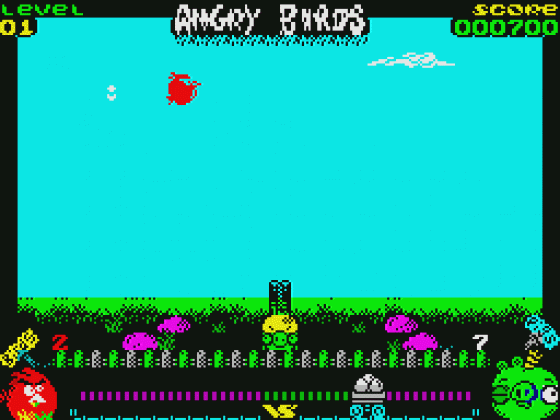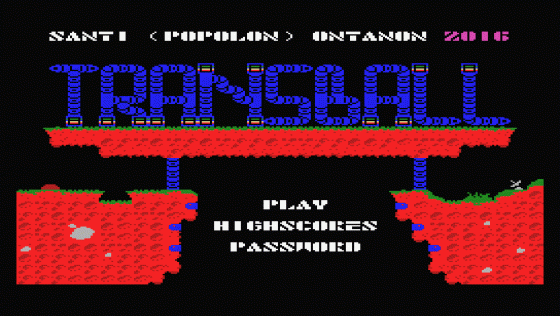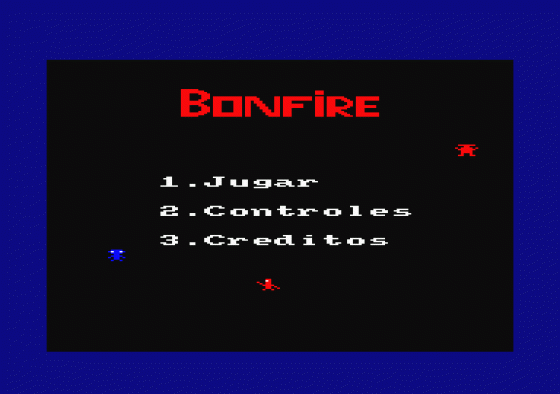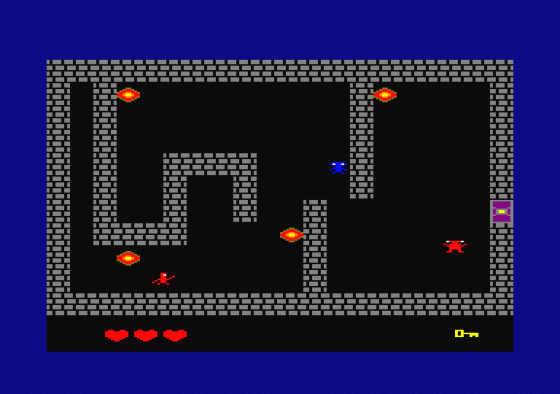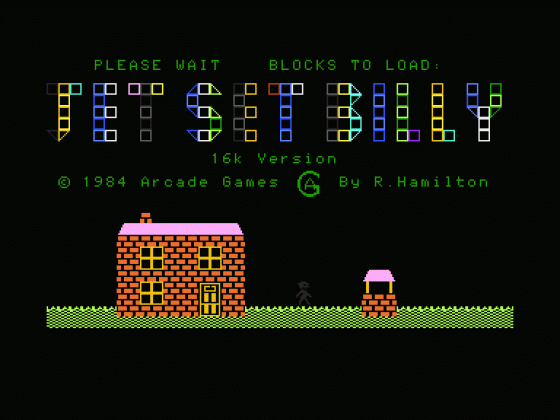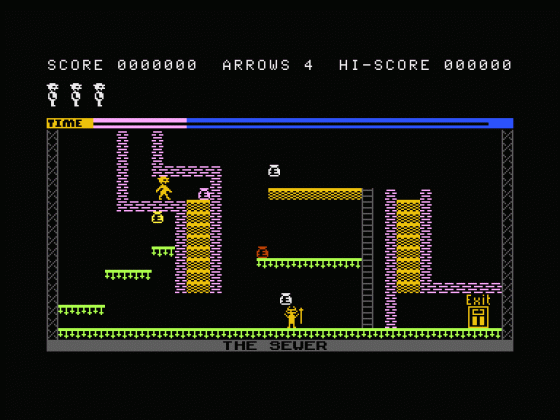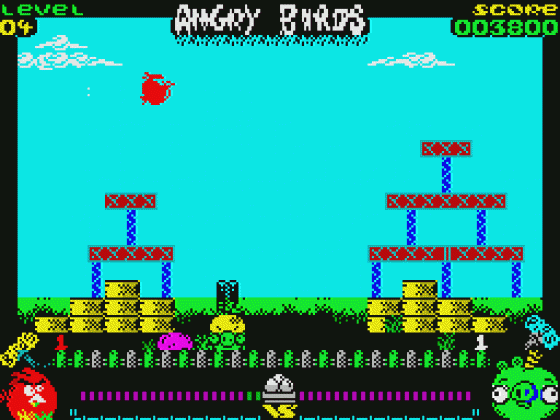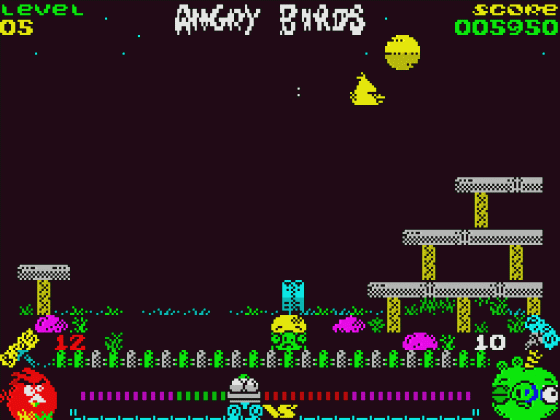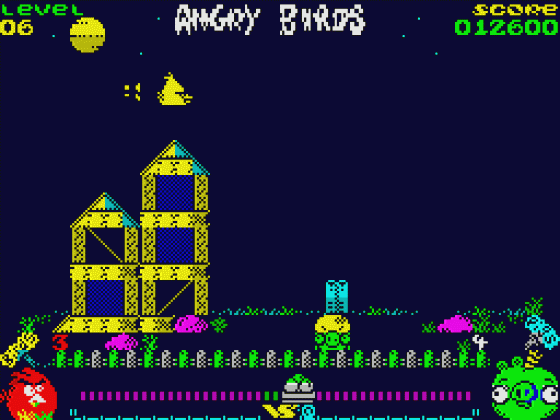
Micro Mart
 11th August 2016
11th August 2016
Categories: Review: Software
Author: Dave E
Publisher: kas29
Machine: Spectrum 48K
Published in Micro Mart #1426: August 2016 Special
This month, Dave Edwads has got the whole of the retro world in his hands
Welcome
Welcome to another month's retro roundup. When I started this column several years ago, a number of people asked me if I would really find enough publishers releasing new games for old systems to fill an entire four pages, month after month. As someone who was heavily "into" the retro scene I doubted their scepticism at the time and, if anything, over the years in between, my simply being responsible for this column has introduced me to lots of retro content I would otherwise have missed.
At some point - perhaps next month - I might take a break from reviewing games for a page or so in favour of charting all of the different sites, YouTube channels and forums that I regularly peruse just to keep abreast of what's new. But two places that have been invaluable, in terms of both research and entertainment, are:
- Retro Revisited's YouTube channel (His own latest Retro Round Up is at www.youtube.com/watch?v=w8NI6gX3msQ), and
- the excellent daily news report at www.indieretronews.com.
These sites don't take the same approach as I do in this column; they don't critically appraise new games, they just report that they have been released. But, simply because they don't appraise, they do pack a lot of retro-related 'press releases' into each month. While this column has occasionally seemed to groan under the weight of new Spectrum games, I'd estimate the Spectrum actually only accounts for a fifth of their output. They cover not only new homebrew games but cracks, previews, demos, competitions, Kickstarter projects, books and gaming conventions.
With these sites as inspiration however, this month I've decided to cast the retro net a little wider. So we'll be looking at five new games and one old one, and for the first time, giving coverage to the MSX and the Colour Genie as well as the Spectrum and Amstrad. So, without further ado, let's see what's new this August.
Angry Birds: Opposition (kas29, Spectrum 48K/128K, Free)
The Angry Birds games were a phenomenal success on modern machines and now they're coming to a Spectrum near you. Well, sort of. Because, although Angry Birds: Opposition features the same lovable sprites as the original, it is actually completely different.
You are in control of a big gun which is situated at the base of the screen. Just below it is a tugrope between the "birds" on the left, and the "pigs" on the right. And dead centre of the tugrope is a cart.
As each level begins, a solitary bird begins to fly across the screen. A quick blast from your weapon and he disappears into a rather nicely animated "poof" of feathers... and that cart quite satisfyingly moves one place toward the "pigs". Miss, however, and the cart will return to the centre. And miss several times and it won't be long until it's pressed up close to the "birds" and they will claim victory, ending your turn.
The aim is, naturally enough, to blast enough birds that the cart presses up against the "pigs" on the right. Doing so lets you proceed to the next screen.
Created by World Of Spectrum member kas29, Angry Birds: Opposition starts off with a deceptive lack of action. The birds move at a fair pace and your stationary gun base deals with them without much problem. However, on screen three, the backdrops start changing and your gun starts gliding uncontrollably back and forth. This ratchets up the difficulty, leaving you less time to react to the birds which appear. Just when you're getting the hang of this, the birds begin to change their flight paths.
There is an impressive amount of variety to this game. Screen backdrops, gun handling and bird behaviour slightly alters every time you manage to shoot enough birds to clear a level. On level six, for example, the screen features a house, and the birds fly behind rather than in front of it, meaning you need even more skill to pick them off when they emerge from its shadow.
In fact, despite its very simple premise and the fact it's all operated with a single fire button, the game is fairly impressive. The only real fault with it is that it doesn't have the smooth scrolling you might expect. The birds move at a fairly regular speed, and I didn't have any difficulty knowing when to hit the fire control to stand a good chance of striking them. But their movement is jerky rather than fluid, which is somewhat distracting. There's also a peculiar vertical scroll upwards when you do win a level.
With a great loading screen and some nice introductory music, it's all put together with quite a lot of finesse and it's so addictive that I did wind up playing it for a good hour or two.
Scores (Angry Birds: Opposition)
Graphics 75%
Sound 75%
Playability 80%
Overall 76%
Transball (Villar Software, MSX, Free)
Transball is a new game for the MSX produced by Villar Software and it's basically a version of the classic Thrust. And, for the benefit of those of you who have either lived in a cave for the past three decades, or forgotten those computer gems of your youth, Thrust is the one with caverns, gravity, lots of careful inch-by-inch manoeuvring and spheres which must be liberated to the top of the screen.
The age-old formula is applied with one large modification in Transball, and the action takes place in the MSX's seven colour mode with 8x8 CHR$ definitions taking the place of the vectors which defined the original. You spin a cyan ship through 360 degrees, trying not to collide with the walls of the caverns, biding your time near to the forcefield-style doors and shooting any gun turrets that give you a hard time.
I've played a few versions of Thrust over the years and Transball combines a great deal of elements that make it one of the most infuriating. Firstly, the ship is overly sensitive, rotating very quickly on its origin and leaping forward with what feels like 645 horsepower at the slightly touch of the thrust control. This takes quite a bit of getting used to. However, you might just master it... were it not for the jumpy vertical and horizontal scrolling. The best I could say about this scrolling is that it's disconcerting. I'm sure others would say a lot worse.
Now these two features make Transball needlessly difficult. Not impossible by any means, but they grate the player somewhat. There's another problem too. Your ship is almost triangular and, particularly if your attention wanders for a fraction of a second, it's sometimes hard to even tell which direction it's pointing in. The original Thrust's ship has a distinct nick where the thrusters were and I never encountered this problem when playing it.
If you can stomach the nail-biting crusade through the caverns to begin your "trans"fer of the "ball" (as per the game's name) to the top of the screen, you may be pleasantly surprised to find that, unlike Thrust, all you need to do in Transball is fly close to it for it to immediately attach itself. This is the large modification to which I referred earlier. There is no dropping of a lasso or Thrust-style tractor beam here. The ball simply turns blue to indicate a successful capture. Indeed, there's no corporeal connection between the ship and ball at all; its colour is the only visual cue - and your ship's grip on the ball can be easily broken if you simply thrust in one direction a little bit too fast. Doing so can easily see your prize flung off into a different section of cavern and you'll then have to spend precious time retrieving it.
Having said all that, one thing the game does have going for it is an amazing intro which includes a cool variation of Eighties music classic Flashdance: What A Feeling. It also has a large number of levels, a password system and no lives system (it simply lets you keep trying the level you've reached until you complete it or quit the whole game).
The game itself doesn't quite pass muster though, being too tough for all but the most hardened arcade addict.
Scores (Transball)
Graphics 54%
Sound 73%
Playability 34%
Overall 54%
Regreso Al CPC (Antonio Cuenca, Amstrad CPC, Free)
Last year was the 30th anniversary of Back To The Future and CPCRetroDev's annual game-writing competition received a slew of games based on the famous Michael J. Fox time-travel movie. Regreso Al CPC, literally Back To The CPC in Spanish, was one of them.
Having travelled back in time to 1985 to source components for your broken Amstrad, the game involves you, in a DeLorean car, travelling along a never-ending road, running over Eighties memorabilia such as cardboard 3D glasses, skateboards and headphones. Watch out for the Sports Almanacs though. These will drain your energy.
If you read that last paragraph again, you'll see that the backstory bears no relation at all to what you have to do. However, what is worse is that, if this game is anything to go by, Marty may actually have hit 1980 rather than 1985; the style of play reminds me of the dark age Tandy CoCo games - and the potential of the Amstrad is only really experienced in the groovy opening and closing musical accompaniments.
As for the rest, it's very unsophisticated fare, with controls limited to up and down and very little incentive to play at all! Music aside, I suspect the game is only a weekend's work. Next!
Scores (Regreso Al CPC)
Graphics 13%
Sound 60%
Playability 7%
Overall 27%
Bonfire (Mythia Fire, Amstrad CPC, Free)
Overhead maze games with patrolling nasties exist in their thousands, and practically every idea has been tried by now. So it was with mixed feelings that I tackled Bonfire, a new game for the Amstrad which invites you to progress through each overhead maze, collecting the key and fighting your way to the door.
Fortunately, there's more to it than at first appears...
Scattered throughout each maze are a number of roaring bonfires (hence the name). You play an Indiana Jones style explorer, sporting one of those open torches of the "rag wrapped around a branch" type, and your aim should be to keep that torch alight. When it is alight, you are impervious to any of the patrolling enemies. As soon as it goes out, they home-in on you at startling velocity.
The strategy you must employ is to cross the maze by running from one bonfire to the next. Unfortunately, although a bonfire will light your torch, it remains lit for only sixty steps. And - wouldn't you just know it? - there are often around seventy steps separating each of the bonfires. Hence the game is one of skill, timing and patience.
Now if all that sounds encouraging, let me warn you that Bonfire is still a little rough around the edges. One particularly discouraging feature, for example, will confront you the very first time you play. You start with three lives at the end of a very long corridor; the first bonfire being guarded by an enemy at the end of it. Get the timing of your run towards the bonfire wrong and not only will you be picked off by the enemy, but he will then stand unflinchingly at the end of the corridor. This leaves you no other option than to suicide-charge away your other two lives in order to start again!
Whilst some things about this game don't really make sense - why doesn't the torch burn if you stand still? - it is an overhead maze idea I have never seen before, so I'll give it a cautious thumbs up for originality. Graphics and sound do, however, leave a lot to be desired.
Scores (Bonfire)
Graphics 25%
Sound 34%
Playability 65%
Overall 41%
Dizzy In The Dungeons (Dr. Titus, PC (Windows), Free) - Retro Find Of The Month
The original Eighties Dizzy was the story of an egg searching for the ingredients for a magical potion and starred an egg-shaped character of the same name. Oddly, when you consider Dizzy appeared on the vast majority of 8-bit formats, its egg-shaped hero became almost synonymous with the Spectrum. Wed in much in the same way as Mario to the SNES, or Repton to the BBC, Dizzy was almost crazily popular. It was more than just "another graphic adventure"; it was a game that just seemed to get all of its elements "right".
In the Eighties the world was also a smaller place and, rather fascinatingly, it wasn't just the English that was going gaga over this Prince of the Yolkfolk. Courtesy of a thriving black market in Spectrums behind the iron curtain, Russian geeks also grew to love him.
Fast-forward 30 odd years and you'll find there are more English and Russian Dizzy games available than you can ever hope to play in your lifetime. Indeed, there's even an annual competition to design the best new Dizzy game. And, this year, with contributions from all over the world, Dizzy In The Dungeons, won it.
So, importantly, is it any good? Well, as you can imagine, being released for Windows PCs - rather than packed into the average 48K most of the Dizzy classics had to content themselves with - does give Dizzy an injection of superior graphics and sound. But what's nice is that the core dynamics of the original games remain the same. Dizzy In The Dungeons retains the platforms, objects, puzzles and that oh-just-a-little-bit-uncomfortable jump feature that we all remember.
There isn't a lot of backstory and there's no cauldron or evil Zaks to defeat. All the instructions tell you are that you must help Dizzy and the Yolkfolk escape their dungeon prison.
Now, the majority of Dizzy adventures I've played before were flick-screen affairs, so you may initially find this smooth-scrolling Dizzy game somewhat unusual. It starts by setting you a single puzzle, which, once completed, will allow you to escape the small prison room in which you are trapped. The solution is remarkably simple but not readily apparent, which is a feature of many of the puzzles to come. So a word of warning: don't do as I did and head over to YouTube to watch a quick video to see if Dizzy In The Dungeons is worth downloading. Believe me, it is - and unless you're careful you'll end up spoiling this first puzzle for yourself if you do.
The scrolling is incredibly smooth and an extremely nice effect is that if Dizzy builds up some extra speed when falling in a certain direction, the screen allows this and then slowly catches up with him to keep him centre-screen. This kind of effect, which likely takes more memory than the entire code that powers many Dizzy games, makes this game stand out as a truly professional release.
There are other nice touches too - you move around with the arrow keys but all getting and dropping of objects is handled by an intuitive menu system. Pressing ENTER picks up an object and immediately selects a menu with "Exit And Don't Drop" selected, so a 'double-click' on ENTER picks up any object. Using an object, you hit ENTER, bring up the menu, select the object you want to use and hit ENTER again. Difficult to go wrong there.
Which makes it all the more astonishing that Dizzy In The Dungeons is all the work of a single die-hard Dizzy fan - David O' Flynn - who has been working on it for over seven years. In fact, if you ever had even a passing interest in Dizzy back in the day, it would be a crime to miss such an impressive game, produced with no Kickstarter backing and being given away for absolutely nothing. It can be downloaded from http://www.yolkfolk.com/site/games.php?game_id=180
Scores (Dizzy In The Dungeons)
Graphics 77%
Sound 72%
Playability 84%
Overall 78%
Jet Set Billy (Arcade Games, Colour Genie, Free)
Jet Set Billy is not a new homebrew game - it's a game from 1984 for the Colour Genie (an "also ran" computer from the Eighties). In it, you play Billy to the strains of "If I Were A Rich Man", and you traverse a number of screens collecting moneybags and avoiding the roaming devils with pitchforks. Quite remarkably, it all fits inside 16K.
There are a number of reasons why I'm giving it a quick once-over this issue. The first is that the Genie's games range from the lamentable to the dross, and it's one of only a few Colour Genie games that is in fact playable. The second is that Colour Genie emulation has been lost to the last generation of Windows users because the only available emulators for this system only ran on the 486 PCs. But that has all changed now with the release of Atilia Grosz's Genieous emulator. The third is that I have been wanting, for a while, to at least give the Colour Genie a bit of column space because, over the past four years, I've been hard at work buying up any Genie cassettes and magazines which have found their way onto eBay. The result is that quite a sizeable collection of exclusive Colour Genie games are available, completely for free, over at everygamegoing.com.
Jet Set Billy however is not a game that I have managed to locate in the "flesh". In fact, I found a ".CAS" file of this British game hiding in a somewhat obscure German database of retro software almost by chance. And what's more - although you might think, given the obvious similarity to Jet Set Willy, that there would be little difference between the two, the games are in fact very dissimilar. If anything, Jet Set Billy seems to have more in common with the original Manic Miner as the game is a purely linear one. You'll only escape room one by collecting all the moneybags to proceed to room two, and so on.
Anyway, I originally picked up Jet Set Billy with a view to fully reviewing it this issue only to find that no instructions for it have survived. As we've experienced before in this column, if a game has no instructions it can lead to certain of its inclusions being completely overlooked. And, in the case of Jet Set Billy, there is an inclusion which seems such a game-changer that hardened Jet Set Willy players might consider firing up Genieous and having a play on this 30-odd year old game simply because it offers something so radically different.
And what is this inclusion? Well, Billy can actually fire arrows at the patrolling baddies...! Which, if you're used to the pixel perfect positioning and jumping of Willy in the Jet Set Willy games, is extremely surprising. But, alas, although Billy can fire arrows, I'm not exactly sure how. Because no instructions have survived, and because so far the furthest I can reach is screen two, I don't know if he needs to collect a bow first to fire them, or whether I just haven't located the game control key that would loose one off.
So it's here, Retro Round Up readers, that I'm actually asking for your help. Does anyone remember this game? Does anyone have instructions for it? Is its author, R. Hamilton, reading this? Or can anyone reading this get further than I can and shed any further light on the mystery? As you can see from the screenshots, Billy has four arrows from the moment he plunges down the well in his garden and starts the game. Can anyone somehow get him to fire one of those arrows and let me know how to do it?
In the hope of receiving a message on Everygamegoing's Facebook page with an answer, I'm going to hold off on actually scoring Billy's antics but give him a cautious recommendation.
That's All Folks!
That's all we have time to cover this issue which hopefully offered something for you all. As is usual, visit the tinyurls to see information, screenshots, downloads and, time permitting, brief videos of the games in action. See you next month.
Other Reviews Of Angry Birds: Opposition For The Spectrum 48K
Angry Birds: Opposition (kas29)
A review by Dave E (Everygamegoing)



